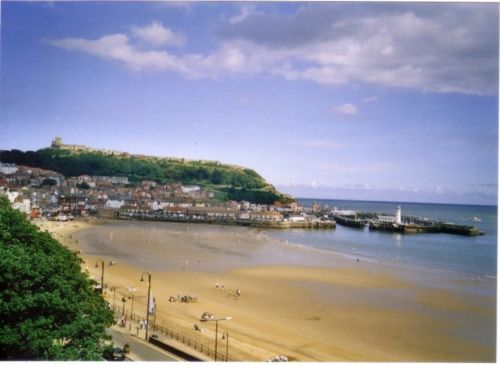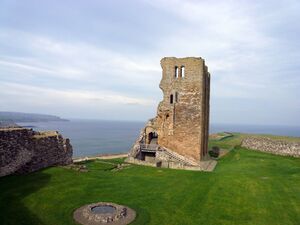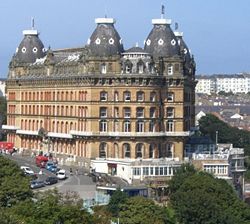Scarborough, North Yorkshire
| Scarborough |
| Latitude and longitude: 54.277331, -0.401791 |
| Population: 50,135[1] |
| District: Borough of Scarborough |
| Region: Yorkshire and the Humber |
| County: North Yorkshire |
| Traditional: (North Riding of) Yorkshire |
| Country: England |
| State: United Kingdom |
| Parliamentary Constituency: Scarborough and Whitby |
| European Region: Yorkshire and the Humber |
| Post Codes: YO11, YO12, YO13 |
| Dialling Code: 01723 |
Scarborough is a town located on the North Sea coast of North Yorkshire, England, 42 miles from the city of York. The modern town lies 30 to 70 metres above sea level, on limestone cliffs. The older part of the town lies around the harbour and is protected by a rocky headland, topped by the twelfth century ruins of Scarborough Castle.
Scarborough has a population of around 52,000, and is the largest holiday resort on the Yorkshire coast. It is primarily known as Britain's first seaside resort,[2] and as a former spa town where the wealthy once visited to take the recuperative waters. Scarborough is also a port for the North Sea fishing industry, and is home to one campus of the University of Hull. Historically, Scarborough is also famous for featuring in a First World War propaganda campaign, Remember Scarborough, following the bombardment of the town by the German Navy in 1914.
The town has two bays, separated by the harbour, with popular sandy beaches and numerous rock pools at low tide. The South Bay contains several amusement arcades[3] and entertainment facilities along the foreshore. The North Bay has traditionally been the more peaceful end of the resort, with Peasholm Park its main attraction. As well as a Japanese-themed island, the park features a mock maritime battle (based on the Battle of the River Plate) re-enacted on the boating lake with large model boats and fireworks throughout the summer holiday season.[4] The "north side" is also known for the 'North Bay Railway', which is a miniature railway running from the park to the Sea Life Centre (a marine sanctuary) at Scalby Mills.
Scarborough has formed the setting for several films and television programmes over the years, which have often made use of the South Cliff Promenade, situated above the Spa area and South Cliff Gardens, with excellent views of the South Bay and old town. Its mix of quality hotels and desirable apartments form the backdrop to the ITV drama The Royal which can often be seen filming in the area. It was also used, with other locations, for the 1998 film Little Voice, starring Michael Caine and Jane Horrocks.
The South Bay has the largest illuminated 'Star Disk' anywhere in the UK. It is 26 metres across and is fitted with subterranean lights, representing the 42 brightest stars and major constellations that can be seen from Scarborough in the northern skies.
History
The recovery of a Bronze Age sword from the site of Scarborough Castle indicates that settlements existed then and at the time of the Iron Age around what is now the 'Old Town', around 900-500 BC;[5][6] possibly something as extensive as a full hill fort on the headland existed, though evidence has of this is yet to be found.[7] Prior to the establishment of the castle in the twelfth century, a fourth century Roman signal station stood on the site. The Anglo-Saxons built a chapel over it around the year 1000; these remains are still visible.[8][9]
Popular lore has it that Scarborough was founded in 966 AD by a Viking raider nicknamed Skardi ('the man with the hare lip'), whose real name may have been Thorgils.[10] While the name of the town quite possibly derives from this name, there is little archaeological evidence to support it. Over a hundred years later, Scarborough was not mentioned in the Domesday Book of 1085 (a survey or census of eleventh century England), implying there was little there to record. An attempt to reconcile this with the Viking story would point to an Icelandic poem of the time by Snorri Sturluson (1178-1241),[11] which claims that the early Viking settlement around the harbour was burnt down in 1066 by William the Conqueror's ally Harald Hardrada, who is said to have built a large bonfire on the headland to supply burning brands to hurl at the villagers below. Other evidence backing Viking settlement points to the arrangement of the streets, some of which seem not to have been laid down in the same way as neighbouring ones, though this may simply have been to avoid a marsh. The first clear evidence of the earliest town coincides with the establishment of the surviving stone castle a century later, around 1163, once Henry II had granted the area the status of a royal borough.[12]
Scarborough recovered under Henry, who removed the first castle established in the 1130s by William le Gros. Henry's stone castle survives as a ruin. Scarborough sprang up as a planned town, in a grid pattern that possibly used the old Roman road as a starting point. the curves in some roads may have followed old field boundaries; the harbour, meanwhile, grew without much planning.[13]
In the fourteenth century, Edward II gave Scarborough Castle to his favourite, Piers Gaveston. There, Gaveston was besieged by the barons, captured and carried to Oxford for execution.
In the Middle Ages, Scarborough Fair, permitted in a royal charter of 1253, held a six-week trading festival attracting merchants from all over Europe. It ran from Assumption Day, 15th August, until Michaelmas Day, 29th September. The fair continued to be held for 500 years.
Scarborough and its castle changed hands seven times between the Royalists and Parliamentarians during the English Civil War of the 1640s, enduring two lengthy and violent sieges. Following the civil war much of the town lay in ruins.
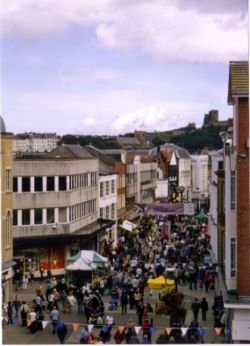
In 1626, Mrs Elizabeth Farrow discovered a stream of acidic water running from one of the cliffs to the south of the town. This gave birth to Scarborough Spa, and Dr Wittie's book about the spa waters, published in 1660, attracted a flood of visitors to the town. Scarborough Spa became Britain's first seaside resort, though the first rolling bathing machines were not noted on the sands until 1735. The coming of the Scarborough-York railway in 1845 increased the tide of visitors.
This influx of visitors convinced the young architect John Gibson to open Scarborough's first purpose-built hotel. In 1841, a railway link between York and Scarborough was being contemplated, and so he decided that the area above the popular spa building could be developed. He designed and laid the foundations of the Crown Hotel, and passed its construction to the newly formed South Cliff Building Company.
On 10th June 1845, Scarborough's first hotel was opened, which was a marketing coup at the time as the local Grand Hotel - soon to be Europe's largest - was not finished. When John Fairgray Sharpin came to visit Scarborough in 1845, he was charmed at first sight by a building which had just been completed and was to let. The hotel is still open for business, but has now been renamed the Crown Spa Hotel. When the Grand Hotel was completed in 1867, it was one of the largest hotels in the world and one of the first giant purpose-built hotels in Europe. A blue plaque outside marks where the novelist Anne Brontë died in 1849.
17 people were killed and about 80 injured when the town was bombed by the German Navy in 1914. This led to a World War I British propaganda campaign, Remember Scarborough, to spur on recruitment into the armed forces.[14]
In June 1993, Scarborough made headlines around the world when a landslip caused part of the Holbeck Hall Hotel, along with its gardens, to fall into the sea. Although the slip was shored up with rocks, and the land has long since grassed over, evidence of the cliff's collapse remains clearly visible from the Esplanade, near Shuttleworth Gardens.
Culture
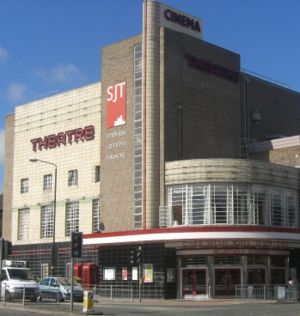
Dramatist Alan Ayckbourn is based in Scarborough, where he has lived for a number of years and is the artistic director of the famous Stephen Joseph Theatre, where almost all his plays receive their first performance. The town also plays host to the annual National Student Drama Festival, which takes place at the Stephen Joseph Theatre, the Spa Centre and other venues around the town.
The area is also home to several galleries. The presence of the University of Hull Digital Arts and Yorkshire Coast College's Arts provision help fuel the town's music and arts scene. Arts, business and education collaborate annually to produce Digital Scarborough - a celebration of the town's digital activities including a wide range of events from business networking to film showings and gigs with DJs and VJs.
The town is home to a significant jazz festival each September, and in the summer boasts 'Beached' - an eclectic rock and pop festival which takes place on the South Bay beach. It features at least 50% local talent alongside internationally known artistes.
These fairly recent developments married to a long established museum and visual arts provision hint at Scarborough's desire to re-invent itself as a creative and arts-based town. In 2006, work started on Wood End Museum - former home to the the Sitwells - to convert it into a creative centre including workspace for artists and the digital cluster plus an exhibition space. The town's Rotunda Museum is currently undergoing a multi-million-pound redevelopment that intends it to become a national centre for geology.
The films Little Voice and A Chorus of Disapproval were filmed on location in Scarborough and the surrounding area. Other films that have filmed scenes in Scarborough include Miranda and Beltenbros.
Education
The town has a small higher education institution, the University of Hull, Scarborough Campus, (formerly North Riding College and University College Scarborough), and is home to Yorkshire Coast College and Scarborough Sixth Form College. The five main state secondary schools in Scarborough are Graham School, Raincliffe School, Scalby School, Pindar School and St Augustine's Roman Catholic School. There are also two private schools: Scarborough College (ages 3-18) and Bramcote (4-13). Scarborough College teaches for the International Baccalaureate rather than A-levels as exams at 18.
Education in Scarborough is notable for its commitment to the digital economy, with 2006 seeing the formation of the University of Hull's School of Arts and New Media at the Scarborough Campus. Scarborough is also the UK mainland's first wireless campus.
Sport
Rowing
The Scarborough Amateur Rowing Club was founded in May 1869, and is the oldest surviving rowing club on the north east coast. For more than 100 years, sea rowing has taken place on the Yorkshire coast between the Tees and the Humber, beginning with friendly rivalry between the fisherman and the miners from Blyth (sometimes known as the German Ocean Race). Rowing takes place throughout the summer months.
Racing
Scarborough is home to the Oliver's Mount racing circuit. This track is composed of twisty public roads and has played host to domestic motorcycling and rallying events for many years. Notable motorcycle racers to have raced at Oliver's Mount include Barry Sheene and Ron Haslam. In racing season, the noise of racers' engines is heard throughout the town, and fleets of motorcycles are seen on the roads.
Football
Scarborough Football Club, formed in 1879, once enjoyed a high placing in the UK's Third Division, but slumped to an all-time low in the lower regions of the non-league Conference North division. After a long, losing battle with unresolved debt,[15] 'Boro' was wound up in June 2007, still owing £2.5 million - though supporters may find a way to resurrect the team.[16]
Though the 'Seadogs'[17] ("No Battle, No Victory") and their seagull mascot sadly never broke into the elite of professional English football, rivalry with York FC was no less fierce than in the premier division. Their best achievement in the FA Cup was in January 2004, when they played Chelsea in the fourth round, losing 1-0 after a hard-fought match.
Economy
Tourism
Tourism continues to be a major part of the local economy, despite the current affordability of foreign holidays. The beaches and attractions are always very busy with "visitors"[18] throughout summer - a marked contrast to the quieter winter months. Confidence amongst hoteliers seems to be high, with 2006 being cited as a good season for many businesses. Several hotels have undergone major refits, often catering to a higher-spending clientèle. Significant amongst these is the Grand, Scarborough's biggest hotel, which overlooks the South Bay. Although the town has attracted unfavourable comments in the past for the Foreshore's emphasis on amusement arcades and derelict or vanishing amenities, grants from the local council, the European Union and Yorkshire Forward, the regional redevelopment agency, have led to several improvements: the Spa conference complex has undergone work, and the nineteenth-century Rotunda Museum is scheduled to reopen in 2008.[19]
Boating
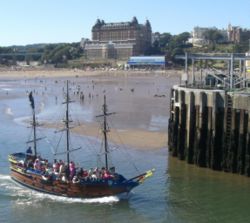
Scarborough's harbour provides many options for taking to the water. Short cruises are available on two classic vessels, the Regal Lady and the Coronia, and for those wishing for a quicker ride, two speedboats take people out into the South Bay. The harbour has two yachting marinas, having converted part of the main harbour which was once used mainly for fishing boats; a few still work out of Scarborough. Perhaps the most unusual boat is the Hispaniola, a converted motor boat made to resemble a pirate galleon. This takes passengers on short cruises in the South Bay; it is well-known locally for controversially sitting derelict for many years after its previous home at the "Mere" - a lake on the outskirts of town - grew too silted for the boat to take would-be young pirates out to a 'Treasure Island' in the middle of the Mere.
Fishing and Markets
Scarborough's fishing industry is still active, albeit as a shadow of its former self. The working harbour is home to a fish market, including a shop and wooden stalls where fresh, locally caught seafood can be purchased.
Scarborough's town centre has major shopping chains alongside boutique shops. The town also has an indoor market, with a large range of antique shops and independent traders in its vaults.
Other industries
Scarborough has been host to various industries over the years. FW Plaxton started a high class joinery business in 1907, and the 1920s brought car manufacturing and then shell cases during the Second World War. Luxury coachbuilding began in the late 1920s and continues today at the Eastfield factory. Plaxton Park on Seamer Road is the site of the former Castle Works factory, which closed in the 1990s when all manufacturing moved to Eastfield, 4 miles to the south of Scarborough. Subject to closure after a disastrous buyout by Transbus, then saved by a management buyout in 2002, Plaxton Ltd upholds the tradition of building state of art coaches and buses for both export and the domestic market.
Printing and graphic design is also found in the town, with major players Pindar and Polestar both based here. Pindar is a Scarborough-born company with an international profile, which also owns the AlphaGraphics chain. The creative industries include a good selection of website design and development businesses, including Save9 - which recently developed an interactive poster/trailer system for cinemas in London, United Kingdom's West End. Graphic design companies include Electric Angel Design, which in 2006 rebranded the international youth organisation the Boys' Brigade.
See also
Footnotes
- ↑ Scarborough Borough Council, 2001 census information
- ↑ Scarborough Maritime Heritage Centre: 'Britain's First Seaside Resort'. Accessed 4th December 2016.
- ↑ Known locally as 'amusements' or 'slots'.
- ↑ Boats which are 'sunk' are remote-controlled; those that survive the battle contain a human operator crammed inside.
- ↑ Walmsley (1998: 3).
- ↑ English Heritage: 'Scarborough Castle - Background Information'.
- ↑ Scarborough Archaeological and Historical Society (2003: 7, 13).
- ↑ Walmsley (1998: 1; 3).
- ↑ English Heritage: 'Scarborough Castle - Background Information'.
- ↑ This story is mentioned but not endorsed on information panels at Scarborough Castle.
- ↑ Monsen & Smith (1989). Translation of the work of the eleventh century Icelander Snorri Sturluson.
- ↑ Scarborough Archaeological and Historical Society (2003: 8).
- ↑ Scarborough Archaeological and Historical Society (2003: 8).
- ↑ Perrett (1991: 20).
- ↑ BBC News: 'Scarborough face winding-up order.' 7th April 2007.
- ↑ BBC News: 'Scarborough FC go out of business.' 20th June 2007.
- ↑ The team were known by various nicknames: the 'Seasiders' being another.
- ↑ As tourists are known to locals.
- ↑ BBC News: 'Renaissance in Scarborough'. 19th August 2006.
